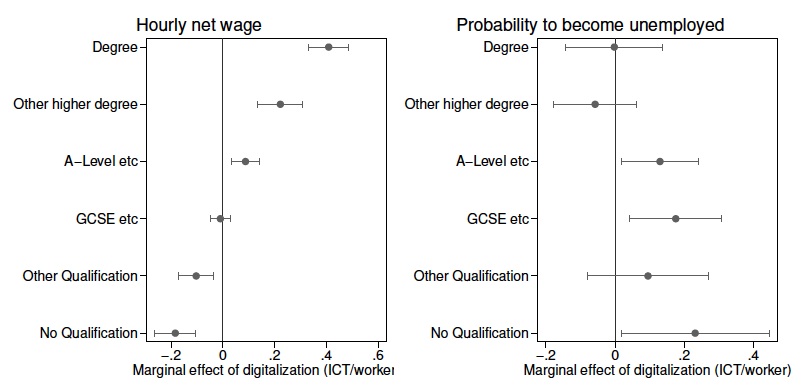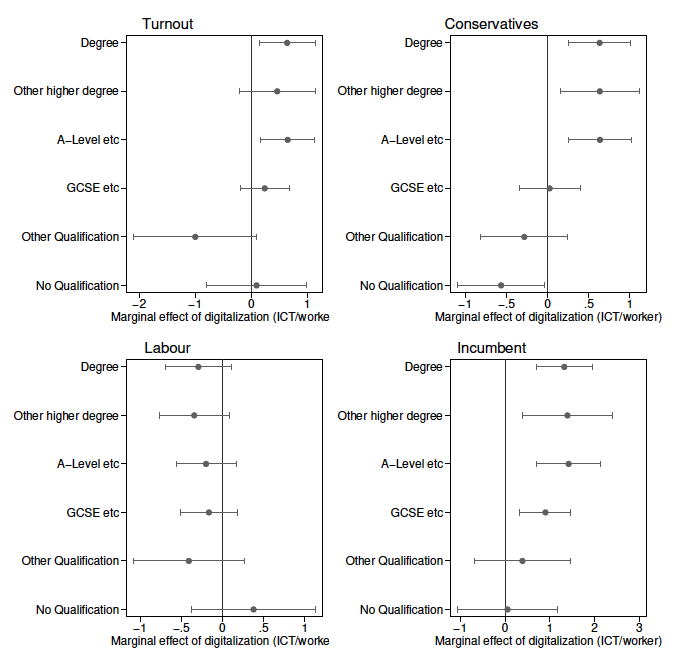Technological innovations have a long history of producing economic change and political upheaval. A popular and recurrent concern nowadays is that digital technologies such as robots and artificial intelligence will replace human workers, create impoverishment, and bring about political instability. Despite the evident distributive consequences of digitalization, the political implications of this economic transformation have received little academic attention. Aina Gallego, Thomas Kurer and Nikolas Schöll empirically analyze the political consequences of digitalization in their Barcelona GSE Working paper (No.1063), “Not so Disruptive after All: How Workplace Digitalization Affects Political Preferences.”
The authors document two main economic effects of digitalization. Contrary to pessimistic views, a large fraction of workers benefit from rapid digitalization in their industries. However, these benefits are not equally distributed as they mainly benefit highly educated individuals. Their novel finding is that these distributive implications also result in individual political reactions, as the voter turnout of highly educated people is higher if their sector digitalizes, and the beneficiaries of digitalization become more likely to support main-stream conservative parties.
Data and estimation
The authors make the empirical analyses focusing on the case of the United Kingdom using longitudinal micro-level data. They construct an industry level measure of digitalization using the EU KLEMS dataset, which contains yearly measures of output, input and productivity for several industries in a wide range of countries, including the UK, and covers the period 1997 to 2017. They combine it with longitudinal data from the British Household Panel Study (BHPS)/ Understanding Society (UKHLS) survey, which is a longitudinal study that interviewed per year up to 10,000 individuals about their economic situation, current and past employment, as well their political and social preferences.
The dependent variables in their analysis are a set of indicators of economic situation and political attitudes asked consistently over time by BHPS/UKHLS: wages, unemployment, voter turnout, support for the Conservative Party and the Labour Party and support for the incumbent.
Concerning estimation, the authors use a fixed-effects panel model with individual by industry-spell fixed-effects and year fixed-effects to estimate the effects of digitalization in a worker’s industry on her labor market and political outcomes. This specification is restrictive in the sense that it only uses over time variation in the level of digitalization within industries for workers who remain at the same industry for at least two periods in order to identify the effect of digitalization on political attitudes and other outcomes.
In addition, their empirical approach employs an instrumental variables model to eliminate the possibility of endogeneity of the measure of digitalization. In particular, ICT capital stocks per worker in the UK, their measure of digitalization, could be affected by governmental policies that also influence workers’ political preferences. They use an analogous measure of digitalization in the USA as an instrument, a technique adopted from the literature on trade shocks. All economic and political results remain qualitatively unchanged, although the instrumental variable approach tends to produce larger point estimates.
Winners and losers of digitalization
The following figure presents the marginal effect of their measure of digitalization on net hourly wages and the probability of unemployment at the time of the next interview for workers with different levels of education.

As can be seen in the first plot of Figure 1, the authors find a positive and strong effect of increases in digitalization in an industry on the hourly net wages of workers with higher education levels, especially, with university degrees. On the contrary, individuals with low levels of education or no qualifications experience a reduction in their hourly wages in periods when their industry digitalizes rapidly.
The coefficients that are shown in the figure can be interpreted as follows: on the one hand, a one unit increase in their measure of digitalization (1,000 pounds ICT capital stock per worker) increases the average hourly net wage of a university graduate by 0.4 pounds, which is equivalent to a yearly net wage increase of 770 pounds. On the other hand, a one-unit increase in digitalization decreases the average hourly wage of workers with no qualifications by 0.16 pounds or 310 GBP per year. The authors consider these wage effects as strong evidence for heterogeneous effects of digitalization: it prominently benefits those who have the skills to thrive in a rapidly digitalizing world.
Next, they examine if digitalization affects the likelihood that workers report being unemployed at the time of the subsequent interview. As the second plot of Figure 1 suggests, they find some evidence that digitalization increases the chances that less educated workers become unemployed after digitalization occurred. This finding is in line with the task-based literature emphasizing that primarily routine jobs in the middle and low end of the wage and education distribution are susceptible to automation.
Overall, the results on the economic consequences of digitalization confirms that it has strong distributional consequences. Digitalization produces income polarization between highly educated – “winners”- and less educated workers – “losers”-, although they find only weak adverse employment effects for workers with medium and low education levels.
Effects of digitalization on political inclinations
The authors´ primary interest is in to know whether and how these distributive effects lead to changes in individual political behavior. The following figure presents the main results regarding voter turnout, support for the Conservative Party, for the Labour Party, and for the incumbent.

As Figure 2 suggests, they find empirical evidence of increasingly unequal political participation due to technological change. Highly educated workers in industries digitalizing more quickly become more likely to vote. A one-unit increase in digitalization raises turnout among voters with university degrees by 0.64 percentage points. In contrast, they find no effects or negative effects among less educated workers.
Furthermore, they study the relationship between digitalization and support for parties. The results provide clear evidence for increased support for the Conservatives among winners of technological change. For instance, a 1000 pounds increase in the capital stock per worker is associated with an increase in support for the Conservatives of approximately 0.6 percentage points among the highly educated. On the contrary, digitalization is accompanied by a reduction in support for the Conservatives for less educated workers. Concerning the support for the Labour Party, the results are not conclusive.
The previous results are consistent with the authors’ initial expectations, according to which workers who benefit from digitalization may become more likely to support an economically right-wing party either due to self-interest reasons or to psychological channels in which positive experiences with creative destruction make workers hold more pro-market attitudes.
The main hypothesis in this case is that through a simple reward-punishment mechanism, winners of digitalization become more likely to support the incumbent while losers withdraw support. Their results provide clear and strong evidence in line with the egotropic economic voting hypothesis: being in a digitalizing environment increases the likelihood of supporting the incumbent, but only for highly educated workers who benefit more from digitalization.




